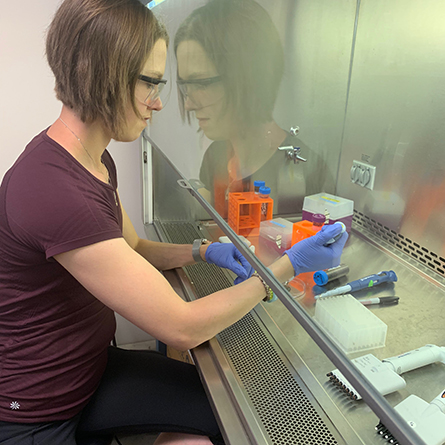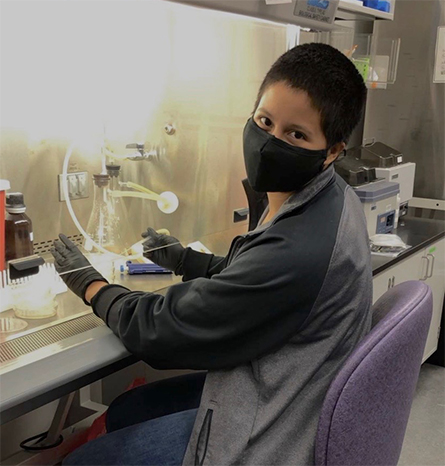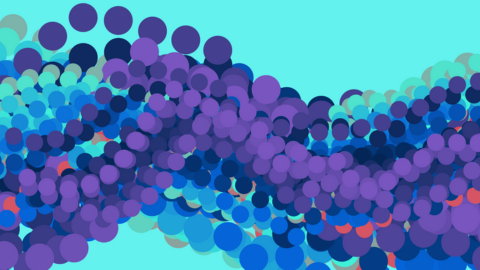Summer undergraduate research weathers the pandemic
The first wave of COVID-19 infections in February and March forced academic labs to decide the fate of their undergraduate research programs, especially summer research. In many cases, that meant canceling research, while in others, students and faculty scrambled to make new plans. As states reopened, grad students and industrial researchers returned to work, but undergraduate research has resumed less consistently.

Undergraduate research programs that were not canceled were reimagined based upon the limitations and guidelines set by their institutions. Some students were able to work in the lab, but even when lab research continued, it was far from normal, according to Joe Provost, professor and chair of chemistry and biochemistry at the University of San Diego.
Making a plan
Provost and a group of science chairs teamed up with his building manager to develop a plan for the university, following state and county guidelines, that would allow students to return to campus. USD offered both on-campus and remote research, with some students doing a hybrid of both.
“Part of the issue was waiting to find out what the rules were,” Provost said. “Eventually, we decided to research what would be as safe as possible and push our administration to allow research once the state allowed such activities.”
Getting students and faculty back into the lab was critical not just for the summer but also as remote teaching in the fall became more likely, Provost said. “The students still need this important event in their experiences of college. Getting into a lab to be creative and learn to be a scientist is important, and having the ability to continue in this mode in the fall makes all the work to get research going even more important.”
Some undergraduates’ time in the lab was limited to essential experiments while they performed other functions remotely. Victoria Soliz, a student at the University of Illinois at Chicago, said, “My lab mentor would recommend me papers to read and ask me questions I should work on answering … In-lab research is only when an experiment needs to be done.”
About 400 miles from Chicago, at Hamline University in Minnesota, Ash Robinson said she performed remote work and also drove to campus to complete key experiments in the lab.
Switching gears
This approach worked for students who could get into their research labs, but some labs were shut down completely for the summer. Many students changed their research methods so they could work remotely. The modified projects included anything from crystallographic structure refinement to computational modeling.
Prior to COVID-19 restrictions, Caleb Rosenthal at Hamline University planned to spend the summer in the lab doing hands-on work, but he ended up involved in bioinformatics, using programs such as Qiime and DNA Subway. He found the transition to be fruitful.
“Now that I am completing bioinformatic research, I am invested in it and find it to be very crucial to the field of science,” Rosenthal said.
Dean Young, also from Hamline, said he realized that “there is more to do with bioinformatics than one could ever hope to accomplish in a single summer.”
Like Rosenthal and Young, Elizabeth Nelson of Boston University found some unanticipated benefits in her new projects. “Since things are remote, I feel the experience has been improved in the sense of responsibility and ownership,” she said.
Nelson’s PI was flexible and enthusiastic about developing a new research plan that involved freedom to explore new topics at her own pace. In a remote format, students could take initiative in their projects and develop a sense of independence.

With the quick change to remote work, some researchers spent significant time reading about their new or modified projects. Several students said that reading articles and learning more about their projects before working on them in the lab provided a deeper understanding, especially for those who were new to their subject matter. Some proposed that an additional period of background research might help students considering starting in the lab even in nonpandemic times.
The challenges
Working remotely did present unique challenges. “Zoom exhaust is a newly discussed and very valid topic,” Nelson said. “It’s challenging to sit in the same seat for three or four hours at a time with back-to-back-to-back (-to-back, sometimes) calls. In the pre-pandemic world, there would be walking in between meeting locations, breaks for lunch, and probably just fewer meetings than now.”
Students noted that internet and computer issues caused problems in processing large data sets. And the adjustment from campus to a new environment did not always support learning new techniques. For example, a remote setup meant students no longer could walk to their advisors’ offices to ask quick questions.
When they had overcome these problems, however, the undergrads said the ends did justify the difficult means. “Another benefit to spending hours on a database or computational tool is gaining fluency with that tool,” Young said. “I am picking up tricks I would have missed from a more casual use and finding ways to extract more relevant information from database searches. This produces skills that can be used in future research and listed on a resume or CV.”
Students generally were grateful that they could complete summer research in any capacity, although they had difficulty recapturing the human connection that comes from working closely with others in a research lab. Marissa Lopez at the University of California, Davis, said, “As human beings we have a dependence on other humans.”
The benefits
Students and their advisors worked to stay connected. Zhela Sabir from Arizona State University said video conferencing actually developed a “sense of togetherness” that otherwise wouldn’t have existed. Video communication helped her realize that “there is a deep value in working as a team,” she said, especially during a global crisis.
Several undergraduate researchers said they built close relationships with their mentors and lab mates as everyone struggled to navigate the pandemic. At Albion College, Jeremy Hogaboom said joint and individual meetings were a valuable part of the summer experience. Students also participated with others across campus in meetings and fitness activities. “(Our research program) has done a wonderful job of cultivating a learning community among Albion students, even when we can’t be together,” he said. “Fun (fitness) challenges ... have been a great way to keep working out and stay healthy during a time where it is way too easy to let your health and well-being slip.”
Other benefits of working remotely weren’t lost on the researchers. With video conferencing, participants could stay up to date on their projects from any location that had adequate internet. Some were able to multitask during meetings, while others spent more time with relatives. Although she might have been more productive working in the lab, Lopez said she valued spending her summer doing remote research while enjoying a cup of cafecito con leche with her family.
Many students said they learned a lot from their experiences this summer and changes that improved efficiency or contributed positively to their understanding of their projects, such as remote video conferencing and additional literature review, should be implemented long term. Victoria Soliz said her lab group hopes to use their additional literature research to write a review paper.
As Elizabeth Nelson pointed out, “It would simply be unfair to go back to normal without retaining any adaptations.”
About the project — and the writers
Undergraduates who aspire to careers in biomolecular science need to show prospective employers and graduate schools that they have research experience. With this in mind, we wondered what types of research experiences students and faculty had managed this summer.
We reached out to American Society for Biochemistry and Molecular Biology Student Chapters to ask students and faculty about their undergraduate summer research. Responses from across the country show how these programs adapted to the pandemic. We learned that summer research looked different for every student this year and that institutions, faculty and students were taking action to create meaningful research experiences in a difficult time.
We are a faculty member at Albion College in Michigan and four summer research students — who all worked remotely on computational projects over the summer in addition to researching this article. (Image below left to right.) Anna Crysler is a junior biochemistry major. Peter Filbrandt is a sophomore biochemistry major. Kaitlyn Piontkowsky is a sophomore biochemistry major. San Pham is a senior biochemistry and music double major. Craig Streu is an associate professor of biochemistry in the department of chemistry at Albion and a member of the Student Chapters Subcommittee of the ASBMB’s Education and Professional Development Committee.

Enjoy reading ASBMB Today?
Become a member to receive the print edition monthly and the digital edition weekly.
Learn moreFeatured jobs
from the ASBMB career center
Get the latest from ASBMB Today
Enter your email address, and we’ll send you a weekly email with recent articles, interviews and more.
Latest in Careers
Careers highlights or most popular articles


Let’s make ASBMB awardees look more like BMB scientists
Think about nominating someone outside your immediate network.

Calendar of events, awards and opportunities
It's time to vote in the society's election, and time's running out to nominate colleagues for the ASBMB annual awards.

Calendar of events, awards and opportunities
Apply for our Advocacy Training Program by April 19. Plus, submit your entry for molecule of the year!

So, you went to a conference. Now what?
Once you return to normal lab life, how can you make use of everything you learned?

Touching the future from the bench
Scholar, scientist, teacher and mentor Odutayo Odunuga discusses the important roles of the institutional PI, his journey and his research.

